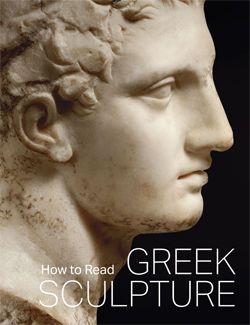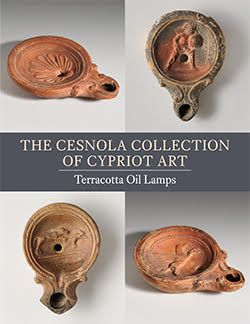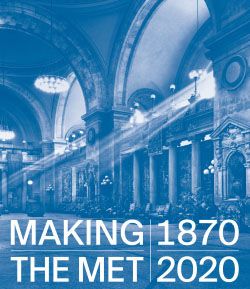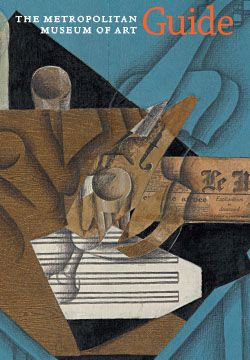MetPublications
Showing 1 – 10 results of 189
Sort By:
 The Gosford Wellhead is one of the most remarkable works of Roman sculpture to enter The Met collection in decades. This Bulletin traces the marble wellhead’s surprising journey to New York, beginning with its discovery in Ostia, Rome’s ancient port, in 1797, and including a long residence in Gosford House, one of Scotland’s most majestic private homes. The authors closely examine the marble wellhead’s superbly carved imagery of two Greek myths related to water: Narcissus and Echo and Hylas and the Nymphs. Uncovering impressive early restorations and featuring a modern technical analysis, this Bulletin provides a focused study of a singular masterpiece whose cultural history weaves from ancient Rome to the present day.Download PDFFree to download
The Gosford Wellhead is one of the most remarkable works of Roman sculpture to enter The Met collection in decades. This Bulletin traces the marble wellhead’s surprising journey to New York, beginning with its discovery in Ostia, Rome’s ancient port, in 1797, and including a long residence in Gosford House, one of Scotland’s most majestic private homes. The authors closely examine the marble wellhead’s superbly carved imagery of two Greek myths related to water: Narcissus and Echo and Hylas and the Nymphs. Uncovering impressive early restorations and featuring a modern technical analysis, this Bulletin provides a focused study of a singular masterpiece whose cultural history weaves from ancient Rome to the present day.Download PDFFree to download Every two years the fall issue of The Met's quarterly Bulletin celebrates notable recent acquisitions and gifts to the collection. Highlights of Recent Acquisitions 2020–2022 include the Mantuan Roundel by Gian Marco Cavalli, a recently rediscovered tour de force from the early Renaissance; the archive of photographer James Van Der Zee, one of the most celebrated chroniclers of Black life in New York City during the Harlem Renaissance; a pair of sculptures by the renowned contemporary American artist Robert Gober; Thomas Sully’s magisterial portrait of Queen Victoria; and Poussin’s Agony in the Garden, one of only two accepted works by the artist in oil on copper. This publication also honors the many generous contributions from donors that make possible the continued growth of The Met collection.Download PDFFree to download
Every two years the fall issue of The Met's quarterly Bulletin celebrates notable recent acquisitions and gifts to the collection. Highlights of Recent Acquisitions 2020–2022 include the Mantuan Roundel by Gian Marco Cavalli, a recently rediscovered tour de force from the early Renaissance; the archive of photographer James Van Der Zee, one of the most celebrated chroniclers of Black life in New York City during the Harlem Renaissance; a pair of sculptures by the renowned contemporary American artist Robert Gober; Thomas Sully’s magisterial portrait of Queen Victoria; and Poussin’s Agony in the Garden, one of only two accepted works by the artist in oil on copper. This publication also honors the many generous contributions from donors that make possible the continued growth of The Met collection.Download PDFFree to download The sculptural tradition developed by the ancient Greeks is justifiably considered one of the most remarkable achievements of Western art. This richly illustrated volume introduces eight centuries of Greek sculpture, from the early rectilinear designs of the Geometric period (ca. 900–700 B.C.) through the groundbreaking creativity of the Archaic and Classical periods to the dramatic monumental achievements of the Hellenistic Age (323–31 B.C.). A generous selection of objects and materials—ranging from the sacred to the everyday, from bronze and marble to gold, ivory, and terracotta—allows for an especially appealing picture not only of Greek art but also of life in ancient Greece. Sculptures of deities such as Zeus, Athena, and Eros and architectural elements from temples are included, as are depictions of athletes and animals (both domesticated and wild), statuettes of dancers and actors, funerary reliefs, perfume vases, and jewelry. The informative text provides a comprehensive introduction and insightful discussions of forty objects selected from the collection of The Metropolitan Museum of Art. Full-page photographs of the featured works are supplemented by many illuminating details and comparative illustrations. The latest in The Met’s widely acclaimed How to Read series, this publication reveals how, more than two millennia ago, Greek artists brilliantly captured the fundamental aspects of the human condition.
The sculptural tradition developed by the ancient Greeks is justifiably considered one of the most remarkable achievements of Western art. This richly illustrated volume introduces eight centuries of Greek sculpture, from the early rectilinear designs of the Geometric period (ca. 900–700 B.C.) through the groundbreaking creativity of the Archaic and Classical periods to the dramatic monumental achievements of the Hellenistic Age (323–31 B.C.). A generous selection of objects and materials—ranging from the sacred to the everyday, from bronze and marble to gold, ivory, and terracotta—allows for an especially appealing picture not only of Greek art but also of life in ancient Greece. Sculptures of deities such as Zeus, Athena, and Eros and architectural elements from temples are included, as are depictions of athletes and animals (both domesticated and wild), statuettes of dancers and actors, funerary reliefs, perfume vases, and jewelry. The informative text provides a comprehensive introduction and insightful discussions of forty objects selected from the collection of The Metropolitan Museum of Art. Full-page photographs of the featured works are supplemented by many illuminating details and comparative illustrations. The latest in The Met’s widely acclaimed How to Read series, this publication reveals how, more than two millennia ago, Greek artists brilliantly captured the fundamental aspects of the human condition. The fourth catalogue in a series that documents the renowned Cesnola Collection of Cypriot Art, this book focuses on the collection’s 453 terracotta oil lamps dating from the Classical, Hellenistic, Roman, and Early Byzantine periods. The rich iconography on many of these common, everyday objects provides a rare look into daily life on Cyprus in antiquity and highlights the island’s participation in Roman artistic and cultural production. Each lamp is illustrated, and the accompanying text addresses typology, decoration, and makers’ marks on each of these objects that provide new insights into art, craft, and trade in the ancient Mediterranean.Download PDFFree to download
The fourth catalogue in a series that documents the renowned Cesnola Collection of Cypriot Art, this book focuses on the collection’s 453 terracotta oil lamps dating from the Classical, Hellenistic, Roman, and Early Byzantine periods. The rich iconography on many of these common, everyday objects provides a rare look into daily life on Cyprus in antiquity and highlights the island’s participation in Roman artistic and cultural production. Each lamp is illustrated, and the accompanying text addresses typology, decoration, and makers’ marks on each of these objects that provide new insights into art, craft, and trade in the ancient Mediterranean.Download PDFFree to download The first of a special two-part edition of Recent Acquisitions, this Bulletin celebrates works acquired by the Museum in 2019 and 2020, many of which were gifts bestowed in honor of the Museum’s 150th anniversary year. Highlights of this volume include a sumptuous set of handscrolls depicting The Tale of Genji, a second-century Roman wellhead, a drawing of a landscape by French artist Claude Lorrain, and nearly one hundred Indian paintings. This publication also honors the many generous contributions from donors that make possible the continued growth of The Met's collection.Download PDFFree to download
The first of a special two-part edition of Recent Acquisitions, this Bulletin celebrates works acquired by the Museum in 2019 and 2020, many of which were gifts bestowed in honor of the Museum’s 150th anniversary year. Highlights of this volume include a sumptuous set of handscrolls depicting The Tale of Genji, a second-century Roman wellhead, a drawing of a landscape by French artist Claude Lorrain, and nearly one hundred Indian paintings. This publication also honors the many generous contributions from donors that make possible the continued growth of The Met's collection.Download PDFFree to download In honor of the institution’s 150th year, this publication celebrates the 203 collectors who committed more than 2,500 works of art to The Met for the sesquicentennial. These meaningful additions change the ways in which we think about the Museum’s holdings and deepen the stories The Met can tell about all the works in the collection. Highlights featured in this volume include an imposing stone head from an Egyptian sarcophagus; an opulent horse armor commissioned by King Philip IV of Spain; a Tibetan war mask; an early American daguerreotype; Sir Edward Burne-Jones’s enigmatic watercolor; an early twentieth-century Japanese bamboo shrine cabinet; poignant photographs made by Robert Frank for his iconic series The Americans; the Cuban American artist Carmen Herrera’s 1949 tondo Iberic; Steve Miller’s 1961 Gibson guitar; important works by Georg Baselitz; art from the Iranian Saqqakhana school; the vibrant bark painting of Aboriginal Australian artist Nonggirrnga Marawili; and recent creations by artists such as Cecily Brown, Peter Doig, Robert Gober, and Wangechi Mutu.
In honor of the institution’s 150th year, this publication celebrates the 203 collectors who committed more than 2,500 works of art to The Met for the sesquicentennial. These meaningful additions change the ways in which we think about the Museum’s holdings and deepen the stories The Met can tell about all the works in the collection. Highlights featured in this volume include an imposing stone head from an Egyptian sarcophagus; an opulent horse armor commissioned by King Philip IV of Spain; a Tibetan war mask; an early American daguerreotype; Sir Edward Burne-Jones’s enigmatic watercolor; an early twentieth-century Japanese bamboo shrine cabinet; poignant photographs made by Robert Frank for his iconic series The Americans; the Cuban American artist Carmen Herrera’s 1949 tondo Iberic; Steve Miller’s 1961 Gibson guitar; important works by Georg Baselitz; art from the Iranian Saqqakhana school; the vibrant bark painting of Aboriginal Australian artist Nonggirrnga Marawili; and recent creations by artists such as Cecily Brown, Peter Doig, Robert Gober, and Wangechi Mutu. The Metropolitan Museum of Art’s renowned collection spans the globe and represents over five thousand years of human creativity. This innovative book celebrates the Museum’s 150th anniversary and highlights its the most popular works while offering fresh ways of exploring visual culture from prehistory to the present. Art = also celebrates the 20th anniversary of The Met’s award-winning online feature, the Heilbrunn Timeline of Art History. The book draws on the diversity of interests expressed by the Museum’s online visitors by featuring wide-ranging texts and images from the most viewed webpages of this popular digital project. Unlike traditional surveys of art history, this volume groups works of art by thematic keywords, providing a new perspective on these well-known paintings, sculptures, photographs, decorative arts, and much more. The nearly 900 works of art in Art = appear across three color-coded chapters: Material/Technique, Period/Place/Style, and Object/Subject. In the first section, works of art are grouped by medium or method such as Drawing, Marble, Watercolor, and Wood. The second section organizes work by time period, movement, or geography, allowing readers to focus on topics such as Ancient Egyptian Art, Impressionism, and Japanese Art. The third section arranges work by motifs, such as Flowers, Food, and Motherhood and by object type, like Furniture, Jewelry, and Self-Portrait. Art = also features more than 160 informative essays written by the Museum’s experts that offer additional cultural and historical context. Color-coded symbols link each essay and work of art to other essays and keywords. The publication’s dynamic structure provides an experience that is different on each reading, inspiring new connections and raising the question: What does art equal today?
The Metropolitan Museum of Art’s renowned collection spans the globe and represents over five thousand years of human creativity. This innovative book celebrates the Museum’s 150th anniversary and highlights its the most popular works while offering fresh ways of exploring visual culture from prehistory to the present. Art = also celebrates the 20th anniversary of The Met’s award-winning online feature, the Heilbrunn Timeline of Art History. The book draws on the diversity of interests expressed by the Museum’s online visitors by featuring wide-ranging texts and images from the most viewed webpages of this popular digital project. Unlike traditional surveys of art history, this volume groups works of art by thematic keywords, providing a new perspective on these well-known paintings, sculptures, photographs, decorative arts, and much more. The nearly 900 works of art in Art = appear across three color-coded chapters: Material/Technique, Period/Place/Style, and Object/Subject. In the first section, works of art are grouped by medium or method such as Drawing, Marble, Watercolor, and Wood. The second section organizes work by time period, movement, or geography, allowing readers to focus on topics such as Ancient Egyptian Art, Impressionism, and Japanese Art. The third section arranges work by motifs, such as Flowers, Food, and Motherhood and by object type, like Furniture, Jewelry, and Self-Portrait. Art = also features more than 160 informative essays written by the Museum’s experts that offer additional cultural and historical context. Color-coded symbols link each essay and work of art to other essays and keywords. The publication’s dynamic structure provides an experience that is different on each reading, inspiring new connections and raising the question: What does art equal today? Published to celebrate The Metropolitan Museum of Art’s 150th anniversary, Making The Met, 1870–2020 examines the institution’s evolution from an idea—that art can inspire anyone who has access to it—to one of the most beloved global collections in the world. Focusing on key transformational moments, this richly illustrated book provides insight into the visionary figures and events that led The Met in new directions. Among the many topics explored are the impact of momentous acquisitions, the central importance of education and accessibility, the collaboration that resulted from international excavations, the Museum’s role in preserving cultural heritage, and its interaction with contemporary art and artists. Complementing this fascinating history are more than two hundred works that changed the very way we look at art, as well as rarely seen archival and behind-the-scenes images. In the final chapter, Met Director Max Hollein offers a meditation on evolving approaches to collecting art from around the world, strategies for reaching new and diverse audiences, and the role of museums today.
Published to celebrate The Metropolitan Museum of Art’s 150th anniversary, Making The Met, 1870–2020 examines the institution’s evolution from an idea—that art can inspire anyone who has access to it—to one of the most beloved global collections in the world. Focusing on key transformational moments, this richly illustrated book provides insight into the visionary figures and events that led The Met in new directions. Among the many topics explored are the impact of momentous acquisitions, the central importance of education and accessibility, the collaboration that resulted from international excavations, the Museum’s role in preserving cultural heritage, and its interaction with contemporary art and artists. Complementing this fascinating history are more than two hundred works that changed the very way we look at art, as well as rarely seen archival and behind-the-scenes images. In the final chapter, Met Director Max Hollein offers a meditation on evolving approaches to collecting art from around the world, strategies for reaching new and diverse audiences, and the role of museums today. In the days before color photography, hand-colored drawings and photographs were the principal means of documenting polychrome Greek art. Beginning in the late 1870s, Émile Gilliéron recorded major archaeological discoveries in Greece shortly after their excavation. This Bulletin, accompanying an exhibition of five watercolors by Gilliéron, features the Swiss draftsman’s drawings of sculptures from the Athenian Acropolis. On view for decades after their acquisition, Gilliéron’s watercolors were eventually retired to The Met's basement, likely in the late 1940s, before the advent of modern conservation practices. Reproductions and copies fell out of fashion, and Gilliéron’s work remained in storage until 2015. In addition to telling the story of the watercolors during Gilliéron’s time, this Bulletin follows the conservators’ heroic efforts to rehabilitate these forgotten pieces. Images of the conserved watercolors, published here for the first time, provide fascinating insight into the sculptures found at the Acropolis as they appeared when they were first unearthed around the turn of the century.Download PDFFree to download
In the days before color photography, hand-colored drawings and photographs were the principal means of documenting polychrome Greek art. Beginning in the late 1870s, Émile Gilliéron recorded major archaeological discoveries in Greece shortly after their excavation. This Bulletin, accompanying an exhibition of five watercolors by Gilliéron, features the Swiss draftsman’s drawings of sculptures from the Athenian Acropolis. On view for decades after their acquisition, Gilliéron’s watercolors were eventually retired to The Met's basement, likely in the late 1940s, before the advent of modern conservation practices. Reproductions and copies fell out of fashion, and Gilliéron’s work remained in storage until 2015. In addition to telling the story of the watercolors during Gilliéron’s time, this Bulletin follows the conservators’ heroic efforts to rehabilitate these forgotten pieces. Images of the conserved watercolors, published here for the first time, provide fascinating insight into the sculptures found at the Acropolis as they appeared when they were first unearthed around the turn of the century.Download PDFFree to download Featuring beautiful color reproductions and enlightening descriptions, this is the definitive guide to one of the largest, and most beloved, collections of art in the world. More than a simple souvenir book, The Metropolitan Museum of Art Guide provides a comprehensive view of art history spanning five millennia and the entire globe, beginning with the ancient world and ending in contemporary times. It includes media as varied as painting, photography, costume, sculpture, decorative arts, musical instruments, arms and armor, works on paper, and many more. Presenting works ranging from the ancient Egyptian Temple of Dendur to Canova's Perseus with the Head of Medusa to Sargent's Madame X, this revised edition is an indispensable volume for lovers of art and art history, and for anyone who has ever dreamed of lingering over the most iconic works in the Metropolitan's unparalleled collection.
Featuring beautiful color reproductions and enlightening descriptions, this is the definitive guide to one of the largest, and most beloved, collections of art in the world. More than a simple souvenir book, The Metropolitan Museum of Art Guide provides a comprehensive view of art history spanning five millennia and the entire globe, beginning with the ancient world and ending in contemporary times. It includes media as varied as painting, photography, costume, sculpture, decorative arts, musical instruments, arms and armor, works on paper, and many more. Presenting works ranging from the ancient Egyptian Temple of Dendur to Canova's Perseus with the Head of Medusa to Sargent's Madame X, this revised edition is an indispensable volume for lovers of art and art history, and for anyone who has ever dreamed of lingering over the most iconic works in the Metropolitan's unparalleled collection.